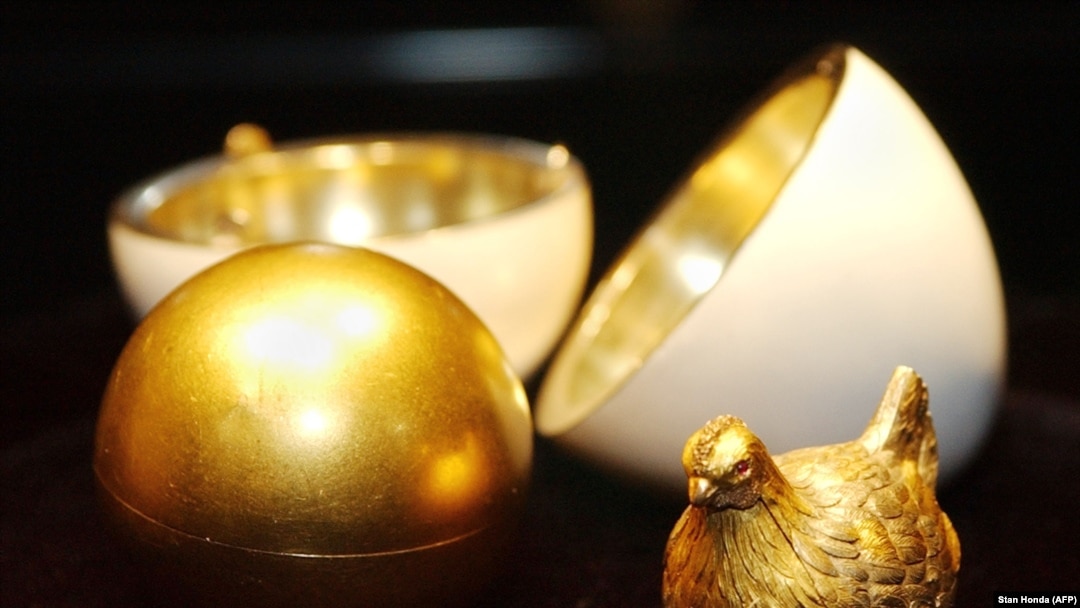One hundred years ago this month, the legendary St. Petersburg firm of Peter Carl Faberge put the finishing touches on the last imperial Easter egg it ever produced: the so-called Karelian Birch Egg. Before it could be delivered to the palace, however, Russia was rocked by the upheaval of the February Revolution and Tsar Nicholas II's abdication on March 15, 1917.
That egg is now in the collection of the Faberge Museum in Baden Baden, Germany -- along with the unfinished Constellation Egg -- an elegant, mute symbol of an irretrievable era.
"In addition to its mass-market production, Faberge created some very expensive masterpieces," says Aleksandr Ivanov, a Russian billionaire who built the Baden Baden museum to house his personal Faberge collection. "Everyone talks about the imperial Easter eggs. Why are they so expensive? First, there are very few of them. Second, over the last 100 years, no one has been able to equal or surpass them."
A total of 54 eggs were made for the Russian imperial family between 1885 and 1917, of which 43 are accounted for today. The tradition began under Tsar Alexander III, who anointed Faberge as "goldsmith by special appointment to the Imperial Crown." Nicholas II had a standing order for two eggs each year, one for his wife, Alexandra, and one for his mother, the dowager Empress Maria Fyodorovna.
The only condition the Romanov tsars made was that each egg contain a surprise. Otherwise, Faberge's craftsmen had complete creative freedom.
A 'Genius Of Administration'
Ivanov, 54, has been collecting Faberge creations full-time since the late 1990s. Although the Easter eggs are scattered in museums and collections in Russia and around the world, Ivanov boasts the widest-ranging Faberge collection in the world, his museum comprising more than 700 pieces, as well as archives and other artifacts.
The only rival collection belongs to Russian oil billionaire Viktor Vekselberg and is on display at the Faberge Museum in St. Petersburg. In 2004, Vekselberg bought the collection of U.S. publishing magnate Malcolm Forbes, which included a staggering nine imperial eggs.
Although the Baden Baden museum has only one finished egg, it is a unique homage to the Faberge legacy. "The Faberge Museum is not just an exhibition," Ivanov tells RFE/RL's Russian Service. "It is also dedicated to the history of the Faberge company and the Faberge family. We have many documents that have never been published before."
The Faberge company itself was the true work of art, Ivanov says. "Carl Faberge was not a jeweler," he says. "We do not know of a single piece produced by his hand. He was a talented administrator. He created the company and surrounded himself with the greatest craftsmen, giving them complete freedom."
Ivanov calls it "the ideal capitalist enterprise."
"He didn't get involved with the craftsmen; he took care of administrative matters and orders. He was a genius at organizing the production," he says. "I doubt that anything like it could be created today. And, of course, there aren't any craftsmen like that anymore."
'Massive Market' In Fakes
After the October 1917 Bolshevik coup, the firm was nationalized and broken up. Faberge fled the country and ended up in Switzerland, where he died in 1920 at the age of 74. His son, Agafon, tried to survive under the new regime in Russia, although he was periodically arrested and jailed. In 1927, with one suitcase -- itself also now in the Baden Baden collection -- Agafon escaped in a sleigh across the frozen Gulf of Finland carrying the unfinished Constellation Egg and a collection of postage stamps that financed his new life in the West. He died in Helsinki in 1951.
Ivanov says that a major part of his museum's work in guarding Faberge's legacy is combating the massive market in fakes. He has challenged as fakes items for sale at major London auction house Sotheby's and says the museum constantly receives authentication requests from dealers in France, Germany, and other countries.
"We simply cannot manage to give a consultation to everyone," Ivanov says. "There is a huge market of fake Faberge." The highest-quality fakes, he says, are usually the products of Faberge's contemporaries that unscrupulous people have stamped with Faberge's hallmark.
But there are also a lot of real Faberge pieces yet to be discovered. Ivanov estimates the firm produced about 120,000 "high-quality" pieces, of which the whereabouts of only some 20,000 are currently known.
Moscow's 'Very Particular' Market
Asked about the market for Faberge in Moscow, Ivanov laughs. "You can't buy in Moscow," he says. "Even I can't buy in Moscow."
"Who are the main purchasers in Moscow?" he asks. "Bureaucrats and people who don't want to advertise their income. They are people with small salaries and bank accounts in the millions. For these people, it doesn't matter if they pay $5,000 or $50,000 or $100,000 or $1 million. These are very particular buyers."
Such buyers also influence the international market for Faberge, Ivanov says. His main competitors at the London auctions are "dealers working on behalf of [Russian] government officials."
When he decided to create his museum, Ivanov initially wanted it to be in Moscow. At the time, he says, under then-Mayor Yury Luzhkov, the city was not welcoming. "It was impossible to purchase a building or get official status for the museum without the right connections," he says.
Instead, he settled on Baden Baden, where local officials offered complete support and the museum was granted federal status.
Ivanov sees himself as the protector of Faberge's legacy. "In another 100 years," he says, "people will speak of Faberge in the same terms as [Italian Renaissance sculptor and goldsmith Benvenuto] Cellini. He has left his mark on the history of the decorative arts. Already Faberge's art is not just Russian. It is part of the global cultural tradition because there are many times more Faberge pieces in the West than in Russia."


